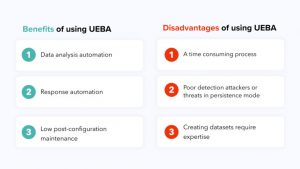User Entity Behavior Analytics (UEBA)
What is UEBA and why is it important?
UEBA, or User Entity Behavior Analytics, is a type of security technology that uses machine learning algorithms to identify unusual or suspicious user behavior within an organization’s network. This can include unusual login activity, unauthorized access to sensitive data and unfamiliar communication patterns.
UEBA is an essential tool to detect and prevent cyberattacks and insider threats. It can help organizations to identify potentially malicious behavior that may not be detected by traditional security measures such as firewalls and antivirus software.

Why do enterprises need to rethink their network security?
UEBA analyzes the behavior of users and entities (such as devices and applications) within an organization’s network. It uses machine learning algorithms to build a baseline of normal behavior and then continuously monitors activity to identify deviations from this baseline.
For example, UEBA will flag a user who typically logs in from a specific location and accesses a small number of files, but suddenly begins logging in from a different location and accessing many sensitive files. From a security perspective, this could indicate that the user’s account has been compromised or that they are attempting to access sensitive information for which they do not have authorization.
UEBA can also detect unfamiliar communication patterns, such as a user who regularly communicates with a few individuals but suddenly begins communicating with many external parties. This could indicate that the user is attempting to exfiltrate data or engage in other malicious activity.

Benefits of using UEBA
- Automated security data analysis The UEBA tool collects and processes numerous logs of daily user and entity activities and events inside the organization’s network.
- Early threat detection – The UEBA tool can recognize changes in user and entity behavior before they breach security rules.
- Automated threat response When the UEBA tool detects suspicious activity, it will alert security officials or respond to it automatically by blocking the process, user or entity behind that activity.
- Early threat detection – The UEBA tool can recognize changes in user and entity behavior before they breach security rules.
Things to consider before implementing UEBA
- Building a baseline of user behavior takes time – The UEBA solution isn’t efficient out of the box, as it needs to be trained on customized user behavior datasets before it starts detecting threats.
- Specific knowledge needed to prepare datasets – Teams will need to spend some time studying dataset preparation or get assistance from an external AI expert.
- Poor detection of ‘slow-cooking’ attacks – Some malicious insiders prefer to take their time to prepare for an attack. For example, they can access and copy sensitive data on a daily basis over a period of time. In this case, the UEBA tool may not consider these actions as suspicious because they are usual for that particular user.
- A costly investments – Configuring, training and integrating the UEBA tool with other cybersecurity tools will take a lot of time and effort.
Conclusion
The UEBA tool provides a proactive mechanism to continuously monitor activity within an organization’s network, identify unusual or suspicious user behavior and prevent cyberattacks through machine learning algorithms. To leverage the benefits of UBEA, both business and technology functions should decide on goals, expectations, and put together a team that can fully utilize the tool for maximum results.
